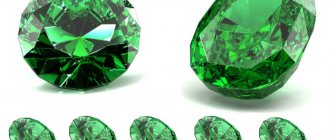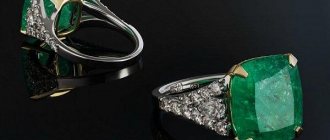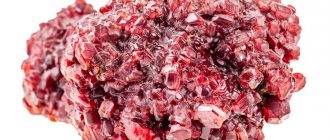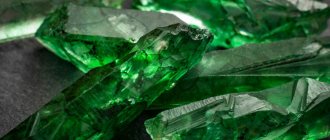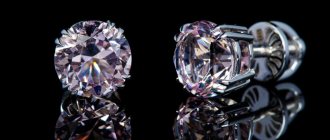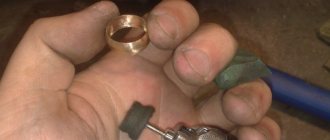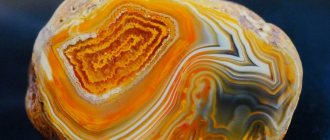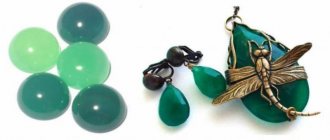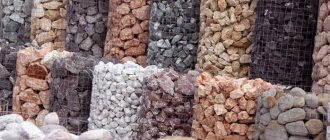Hello, dear readers! Emeralds have attracted the interest of mankind since ancient times; even the rulers of Egypt loved not only jewelry made from them, but also preferred to wear clothes inlaid with them. This type of beryl is not found in nature as often as diamonds, so their prices are often higher. Unfortunately, unscrupulous craftsmen take advantage of this and try to pass off other cheaper stones as gemstones, so the table of emerald purity can help you understand where the real nugget is and where it is an imitation.
How to correctly assess cleanliness and size
In the global community of jewelers, there is a special classification of emeralds based on color and clarity. Ordinary people also, when purchasing jewelry with inserts of these precious stones or just semi-precious stones, should know how to evaluate the size, clarity and cut of the mineral:
- First of all, it is necessary to check for the presence of various inclusions in the nugget.
A real stone, even an artificially grown one, will contain inclusions of gaseous bubbles, crystals, etc. They can be viewed with a magnifying glass. It is worth noting that specimens with an excessive amount of inclusions are cheaper, since this reduces their purity and transparency.
- Next, you should pay attention to the cut of the mineral. Cutting green beryl is a very labor-intensive process, since due to inclusions the stone can be quite fragile and simply crumble.
Green gems are most often cut into rectangular shapes. The gem must be cut in such a way as to protect the crystal from damage during use. A high-quality cut enhances the natural qualities of emerald, enhancing its brilliance, saturation and depth of color.
- It should also be taken into account that the cost of an individual copy does not always depend on its size.
In most cases, large nuggets actually cost more than small ones. But it is worth saying that in large minerals you can often find many inclusions, which detracts from their characteristic such as transparency, so you should not be surprised if the price of an emerald of medium size, but of impeccable quality, turns out to be higher than the cost of a fairly large stone.
Table for determining the purity of a stone (with photo)
If you want to independently figure out what kind of emerald is in front of you and how pure it is, then we advise you to refer to the table below.
Emerald
Emerald is a variety of the mineral beryl with a characteristic bright green color. Emerald belongs to the beryl family, whose crystal structure consists of aluminum and beryllium. The remaining varieties of the beryl mineral are aquamarine (blue, blue-green), morganite (pink, yellow-orange), goshenite (colorless) and heliodor (yellow, gold). The bright green color of emerald is due to the fact that in the structure of beryl, aluminum is replaced by chromium. However, there is green beryl, which is not an emerald because it does not contain chromium. Emerald in parent rock
Color: from emerald to grass green of varying intensity Hardness: 7.5 - 8 Density: 2.67 - 2.78
The name "emerald" comes from corruptions of the Latin esmeraude and Greek smaragdos, both of ancient Indian or Semitic origin; originally it seems to have meant "green stone" and referred to a wide variety of green gemstones. Emerald is the most valuable of the beryl group minerals. The deep and rich shade of its green color cannot be compared with anything; it is called “emerald green” (and not only in relation to minerals). The color of emerald is due to the presence of chromium and sometimes vanadium ions in its composition; it is able to withstand sunlight and heat, changing only at a temperature of 700-800 ° C. Only the highest quality emeralds are transparent. More often they are clouded with inclusions of liquid or gas bubbles, other minerals, as well as healed cracks. Small inclusions are not considered significant defects, indicating the natural origin of the stone (as opposed to synthetic stones and imitations).
Stones of a deep green tone are most valued; even if there are inclusions, they are preferred to be pale-colored, even if almost transparent. The luster of emerald is usually vitreous. Physical properties from different deposits vary somewhat. A characteristic feature of the stone is increased fragility; in combination with the thin cracks often found in emeralds, it makes this stone very sensitive to pressure and heat. But it is resistant to acids and other reagents.
Main deposits: Colombia, Zambia, Brazil, Pakistan, Zimbabwe, Afghanistan, Russia (Ural), Australia.
Due to the fact that emerald is a fairly fragile stone, it is cut very carefully. The classic cut for emerald is Emerald 65 facets (I-65),
This cut has specific beveled corners to prevent them from accidentally chipping when setting. Classic emerald cut emeralds are valued higher than emeralds cut in other (fancy) shapes. Often, for stones that are not completely transparent or opaque, a form of processing is used - cabochon. In relation to the I-65 cut, all other emerald cut shapes can be considered fancy.
Expert assessment of emeralds.
Expert assessment of emeralds in Russia is carried out on the basis of TU 95.335-88 “Natural processed emeralds” dated January 1, 1991, which provides technical requirements for cut emeralds. The main indicators of the quality of emeralds are: - color, - purity, - weight, - type of cut, proportions and quality of processing.
There are 5 groups of emerald colors
depending on color tone and lightness. When describing the color of an emerald, its shades are not indicated - bluish or yellowish, although these are the shades that are most characteristic of emeralds.
| Color group | Description |
| 1 | Dark green |
| 2 | Medium dark green |
| 3 | Medium green |
| 4 | Medium light green |
| 5 | Light green |
Assessing the purity of emeralds
characterized by their transparency, the manifestation of internal natural inclusions, cracks that determine the appearance of the cut stone. Depending on the manifestation of the above parameters, emeralds are divided: - faceted - into three purity groups (G1, G2, G3), - cabochons - into two purity groups (K1 and K2).
The purity of emeralds is determined visually with the naked eye, without the aid of a magnifying glass.
| Cleanliness groups | Faceted | Cabochons |
| 1 | Emeralds are clean and have minor blemishes in the form of cracks, stripes, and pinpoint inclusions in various areas of the stone. Emeralds have sparkle and play. | Cabochon emeralds with defects in the form of a network of cracks, stripes, inclusions, with areas of cloudiness in various zones of the stone. Transparent and translucent emeralds have shine and play. |
| 2 | Emeralds with small defects in the form of cracks, stripes in combination with point inclusions of other minerals, forming condensations and a network in certain zones of the stone. Emeralds have sparkle and play. | Cabochon emeralds with large defects in the form of a dense network of cracks, stripes, inclusions, with areas of opacification throughout the stone. Emeralds are translucent and opaque, having partially lost their shine and sparkle. |
| 3 | Emeralds with defects in the form of cracks, stripes, pinpoint inclusions of other minerals located throughout the stone, with areas of opacification in certain areas of the stone that have partially lost their shine and play. |
How to evaluate the color of a mineral
Emeralds can be colored in almost any shade of green, ranging from deep dark green, velvet-like, grassy, to light greenish. The color of the mineral is determined by the content of substances such as chromium, vanadium and iron, as well as the conditions of the natural environment where the nugget was formed.
Colombian and Zambian crystals are characterized by the richest saturated pure green without various impurities of blue and yellowish tints.
Also, when buying a gem or jewelry with it, you should pay attention to the tone of the emerald; dark emeralds are more expensive than light ones. The most valuable in jewelry are the medium and medium-dark tones of the mineral. Excessively blue or yellowish tones of a nugget often indicate that it is not a green beryl.
It is also important to be able to evaluate a gem by its color saturation. Clearer stones cost more. Minerals with a large number of inclusions are rarely transparent, just as excessively dark nuggets are cheaper.
Tips for choosing an emerald
When choosing jewelry, you need to take time to follow several recommendations:
- Hue. The standard color of emerald 3-3 is green. Only most stones do not have a pure color; most often they play in different shades. Upon careful inspection, additional yellow and blue shades can be seen. It is by these that the quality of the jewelry is assessed. It is interesting that preferences for colors in stone change depending on fashion trends. For example, if warmth is in fashion, yellowness will be valued more, if cold - blueness. The only thing that will forever remain unchanged is the popularity of high purity emeralds.
- Saturation and tone. The color range of minerals in nature can vary from the palest and lightest to almost black. The most expensive ones should meet the tonality of up to 70%. This color is considered the purest and is in great demand among jewelers. At this time, pale green goods can be valued at several dollars per carat. The gray tint in the mineral practically devalues it, since it is not used for making jewelry. The most common saturation is considered to be the one closest to the standard green color.
- Origin. It also greatly affects the cost of the jewelry. A professional craftsman can easily identify a stone deposit by visually examining it. For example, the Colombian mineral has a yellow color. This deposit has increased popularity, but not because the rocks there are cleaner and of better quality, but only because of successful advertising. There are also Zambian gems. They can be recognized by their additional blue tints.
Emeralds 3-3 are not a cheap pleasure. If you want to find a beautiful piece of jewelry, but at an affordable price, you can ask for minerals with impregnated defects. This is a product usually impregnated with cedar oil. The quality will be lower, but without checking it will be difficult to distinguish it from an expensive product.
Pedigree nugget
For those people who know how to choose the right emeralds, focusing on the purity, color and size of the mineral, its origin is important. Of course, almost every emerald connoisseur will choose a gem mined in Colombia, while an equally beautiful specimen from Afghanistan or Pakistan will be put aside.
Preference is given to Colombian nuggets not only because of their beauty and impeccability, but also because of advertising. After minerals from Colombia, people are eager to get their hands on Zambian green beryls.
In fact, a wonderful gemstone can be mined from any corner of the earth.
Purity
The next factor is the purity of the emerald. Jewelry emerald is classified as a type of stone that typically contains a large number of inclusions and cracks, so the assessment of purity is not very strict. Gas-liquid veils usually act as inclusions, which can add some “liveness” to a pure cut emerald with their iridescence in the light. Absolutely pure, large, transparent specimens, without inclusions or cracks, are practically never found in nature; they are extremely rare. Opaque (impure) pieces of raw material are usually used to make cabochons. They, of course, have a much lower cost.
In the photo: samples of similar quality. However, the example on the right has a dark contrasting inclusion that immediately catches the eye. Therefore, the purer emerald on the left looks better
“Practical advice. After you evaluate the color, evaluate the purity. Make sure the stone is well rubbed and free of surface contamination. First check for cleanliness with the naked eye in good lighting. Are there any large cracks or inclusions that are noticeable? It is advisable that they are not in the center of the stone. See if internal irregularities greatly affect the overall attractiveness of the stone. You can then check whether the emerald is pure using a 10x triplet loupe for a more thorough analysis. At the same time, pay attention to whether there are large cracks in the sample that extend to its surface. The presence of such defects affects the quality and they can affect the durability of the stone. For example, from a slight accidental blow it can split along these cracks. The number of even barely noticeable cracks emerging on the surface of the faces should be minimal. Surface cracks are best seen in reflected light; to do this, you need to position the emerald relative to the light source in such a way as to catch the highlights on the edges.”
Does refining a gem affect the price?
True connoisseurs of emeralds know that refining reduces the cost of a stone by 40-60 percent, that is, an unrefined mineral of the same quality will cost many times more. But today it is almost impossible to find an impeccable nugget that does not need refining.
Most often in Russia, cracks in a gemstone are hidden using cedar oil; this refining process can be carried out more than once. Finding jewelry that is not oiled is actually not that easy.
Emerald deposits
High-quality emeralds are rare and are mined in countries such as Colombia, New Granada, Zambia, Brazil and Egypt.
Low quality samples are common in Austria, Ireland, and Norway. — Advertising —
In addition, Russia, USA, Canada, Australia, Spain, France, Switzerland, Italy, Germany, Bulgaria, Kazakhstan, Pakistan, Afghanistan, India, China, Cambodia, Ethiopia, South Africa, Somalia, Nigeria, Namibia, Tanzania are well known among emerald suppliers. , Zimbabwe, Mozambique and Madagascar.
How to buy smaragd
People who are far from gemology may have difficulties when buying jewelry with emeralds, so it’s worth finding out how to make this task easier:
- Use the services of a reputable jewelry store that complies with the terms of the guarantee and return of jewelry;
- Invite an independent appraiser to evaluate an expensive piece of jewelry;
- Read the report from the gemological laboratory about the emerald that you like; it will indicate the size, transparency, type, color, cut and origin of the mineral.
Before you go shopping, it is important to study the pricing policy that determines the cost of this type of beryl. In order to understand whether a suitable piece is worth the amount for which it is sold, you can contact several jewelry workshops and ask experts to evaluate it.
History of emerald
The term “emerald” has Persian roots, which were transformed into the Latin smaragdus and were then used by many peoples of the world.
Even in ancient times, emeralds were highly valued. In Babylon they were an object of trade as early as 4000 BC. e. Ancient Egypt was famous for its emerald mines, which were discovered in the 19th century along with tools from 1300 BC. e. The rulers of India also valued emeralds. Sultan Shah Jahan, who built the magnificent Taj Mahal, the greatest symbol of love and fidelity, used emeralds as talismans. In addition, they were engraved with sacred texts.
And now, like many centuries ago, emeralds remain one of the most popular gems.
Record emerald
— Advertising —
The world's largest emerald, originally from Colombia, was named "Fura". Its weight was 11,000 carats and its price was $150 million. The second largest mineral, named “Tena,” weighs 2,000 carats. The record holder for cut stones called “Theodora” weighing 11.5 kg was valued at $1,500,000. Before treatment, his weight was 28 kg.
How to distinguish an artificial emerald from a natural one
Artificial emerald is very similar to natural stone, but its specific gravity and refractive index are lower. In addition, it is characterized by a bluish-green tint. In the Chelsea filter it looks bright red. It is also possible to distinguish between natural and synthetic emeralds using ultraviolet radiation (wavelength 360 nm), a real stone does not react to it, but a synthetic one luminesces in a chestnut-brown color. But this pattern may not be observed.
Artificial emerald
Since the 19th century, scientists from many countries have been involved in the task of creating artificial emeralds.
For the first time this was possible only in 1935 in Germany, when G. Espig and his colleagues obtained the so-called “igmerald”. 5 years later, industrial production of the synthetic mineral was established in the USA. Today, artificial emeralds are produced in countries such as Germany, France, Switzerland, Japan, Russia and Belarus. The world's largest (a joint enterprise between Russia and Thailand) synthesizes emeralds that are identical in chemical composition to natural Colombian ones. Synthetic emeralds often reach large sizes up to hundreds of carats, but the technology for their production remains a secret of the enterprises and is not disclosed.
In general, modern synthetic emeralds are no different in appearance from natural ones, and the quality is even higher. Moreover, their price is much lower than natural stones, which are quite rare.
